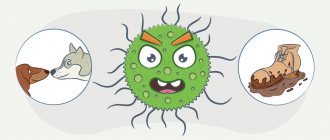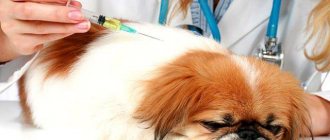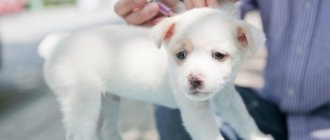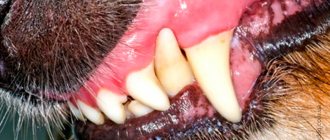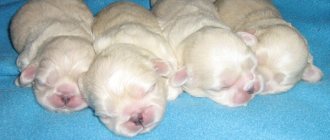What to do after the birth of puppies?
Take time off from work so you can spend as much time at home as possible. This way you can observe how the bitch behaves, especially if this is her first litter. Note for yourself the important moments of your mother’s behavior. If you plan to regularly breed puppies in the future, the experience gained will be invaluable to you.
During a normal birth, and if the bitch is already experienced, it will not be difficult to care for the babies, since from birth they already have certain reflexes . An adult dog has a very strong maternal instinct. If this is not the first litter, the bitch will carefully look after the children, carefully licking them, protecting them and feeding them.
Newborn puppies. Care in the first days of life
Newborn puppies are blind and deaf
Babies are born blind and deaf, however, thanks to instincts, from the first hours of life they are able to independently find their mother's nipple . The feeding process usually looks like this: the puppy attaches itself to the chest and begins to massage the area around it with pushing movements with its front and back paws. This helps produce and supply more milk. An important point: it is necessary to put babies to the breast in the first hours after birth so that they eat nutritious colostrum. It contains many vitamins, proteins and other useful substances. The baby’s immunity will be strengthened, and various infectious diseases will not be scary for the growing body.
In the first few days after birth, puppies cannot empty their bladders or bowels on their own. The bitch does this for them, diligently licking the babies and eating all the secretions. Therefore, newborn puppies lie dry and clean, and there are no marks on the bed. Blind and deaf babies mostly just sleep and suck, rapidly gaining weight. If the puppies do not squeak, it means they are full.
Bitch after giving birth
Try to be there for a few days after giving birth.
If the bitch had a caesarean section, in the first days after the operation she will not be able to independently care for the offspring. You will have to take this responsibility upon yourself. Massage the babies' bellies with a damp, warm cloth. Having recovered from anesthesia, the bitch may be shocked: where did so many new residents come from? There is a high probability of such a development of events if this birth is her first. When the puppies start crawling around and looking for the nipple, this can make the bitch nervous. Therefore, when the animal has completely recovered from anesthesia, place one puppy in its bed and monitor the reaction. Only if everything went well, can you move all the other kids there. The mother will be cautious and a little aggressive with them until she gets used to it. So try to be there constantly for a few days after giving birth. If this is not the first litter, she will accept them normally and will properly care for the puppies, even with an unhealed suture . In order not to harm the mother, you can keep her newborn babies separately for several days, in a box with a heating pad, placing them next to it only during the feeding period.
If the bitch has no interest in babies, she may be sick. Call a veterinarian immediately for an examination.
Useful information: You should not leave the mother alone with the puppies if this is her first litter. Not every dog exhibits maternal instinct; without supervision, it can harm babies (gnaw off limbs or even eat them completely). Fortunately, this rarely happens. Most often, after a few days, the mother gets used to her role.
Buying a puppy: how to determine the character and not make a mistake with the choice of temperament
In order for the character of the future pet to best match the temperament of the owner, it is very important to choose the right baby. Pay attention to:
- Activity level. In the litter there will be calm puppies and those about whom the catchphrase comes to mind about the presence of the notorious “awl” in the body. Such active kids are unlikely to be able to live comfortably next to a person leading a calm and measured lifestyle. But they will become ideal companions for people who are in endless movement, travel and various trips.
- Communication skills. Take a closer look at the kids. One of them may show pronounced goodwill towards the future owner, strive to communicate or flirt. Perhaps a certain connection has already been established between the puppy and the future owner, which will subsequently develop into a strong friendship;
- If the baby shows aggression, growls and categorically refuses to make contact, then you should not insist. Even if its appearance is 150% consistent with the wishes of the new owner. There is no guarantee that with age the owner will be able to overcome the baby’s hostility, and the adult dog will not show aggression.
This is important: A good solution would be to consult with a zoopsychologist or an experienced dog handler. A specialist will tell you how to choose the right puppy with the most suitable temperament.
Feeding newborn puppies
Puppies often do not gain weight in the first few days.
Puppies are born with an innate sucking reflex. However, weak babies who are unable to latch on to the nipple themselves must be held until they have received their share of milk. Apply them to the fuller nipples. First, knead the bitch's chest and express the colostrum so that the puppy can smell it. So he will need to be fed for several days. Then the puppy will get a little stronger and will be able to feed on its own.
Useful information: Healthy babies know how to grasp the nipple tightly, they lift their tails up, sleep well, and have wet noses. If there are lethargic and inactive ones, they need to be shown to a veterinarian.
It is very important to weigh a newborn puppy and subsequently monitor how he gains weight and how much food he takes at a time . If the baby is very weak and cannot suck even a drop on his own, he will need to be fed every 1.5 hours from a pipette, syringe or pacifier. To do this, express the mother's milk and give it to the puppy little by little. For the first time, 1 milliliter will be enough.
When the puppy grows a little, increase the amount of milk to 5-10 milliliters. This can only be done after 2 weeks.
Often, in the first few days after birth, babies do not gain weight, and sometimes they can even lose a little weight. But after a couple of days, positive dynamics should appear. If this does not happen, it means that the bitch does not have enough milk to feed the children. You will have to additionally feed the growing body
Often the mother has an excess of milk that remains after feeding. To avoid congestive mastitis, regularly examine your dog's chest and express any excess. This may be due to the fact that she gave birth to only one puppy, which simply cannot suck all the milk. The nipples most commonly pulled by puppies can be swollen, hard, and hot. Owners who encounter a brood for the first time sometimes forget to examine the upper glands, which the babies do not touch. However, milk may also remain there; you need to keep an eye on this. Check all nipples regularly, massage them and express any remaining milk.
Dog categories: pet and show.
The choice of breed has been made, now you should think about which category (class) puppy to take.
When you call a breeder about purchasing a puppy, you can usually hear him ask: “What is the purpose of the dog? “, that is, the breeder asks you whether the dog will be just a pet, a companion (pet) or with prospects for breeding shows (breed-show).
- Pet /Pet. Translated from English, pet means “domestic animal.” Such dogs, as a rule, have deviations from the standard, which do not allow them to participate in breeding and exhibitions. For example, a puppy has a non-standard color or an incorrect bite or a crooked tail. These deviations do not interfere with an active and healthy life, and the cost of the puppy is much cheaper.
- Breed Show . Show-Breed. These puppies meet the breed standard as closely as possible. It is expected that they will participate in exhibitions and possibly breed. Such puppies usually have an excellent pedigree; they are outstanding representatives of their breed.
It often happens that a person takes a pet class puppy, and later, when the dog grows up, the owner has a desire to participate with his pet in exhibitions. There is nothing wrong with this, since often the dog’s shortcomings are insignificant and even allow him to win in shows. But, if a dog has a significant deviation from the standard, then it is natural that at the exhibition it will receive a very low score or even disqualification.
Thermoregulation of newborn puppies
In the first week of life, babies do not have a proper thermoregulation system. Even if they are cold, their body will not tremble. So you will have to monitor the temperature in the bed if they grow up separately from their mother, or make sure that they are always close to their mother. To keep the temperature normal and the puppies not to freeze, it is necessary to place them close to each other. If the cot is colder than +30°C, there is a chance that the babies will freeze.
Short-term mild hypothermia will not harm the puppy’s health, but, on the contrary, will strengthen the immune system. This way the puppy will gradually get used to growing in natural conditions. But longer hypothermia can threaten the puppy's life. This problem can be solved by placing an electric heating pad in the baby's bed. Remember that it does not need to be installed over the entire area where the puppies live. If the bitch gets hot, prepare a place where she can move without leaving the children.
Gender of the puppy. Bitch or male?
It is impossible to give a definite answer to this question, but we advise you to focus on personal sympathies.
Males
- Larger and more powerful than bitches;
- They have a stronger sex drive and, if you encounter a bitch in heat while walking, the dog must be kept on a leash, since holding commands often do not help. If at this time the male is in free flight, he may run after the female. Good training will help.
- Males of small breeds can mark corners and furniture.
- Large individuals can be very aggressive and dangerous.
- The behavior and character of male dogs is simple and uncomplicated. An attentive owner quickly guesses what is on the dog's mind.
Bitches
- Bitches are usually smaller and lighter.
- More affectionate, less aggressive and pugnacious, they become more attached to their owner.
- Bitches are usually more obedient and easier to train, but they are also more cunning than males.
- Bitches go into heat 2 times a year (rarely once a year). Due to a hormonal surge, they can become nervous and disobedient, or more affectionate and playful. During the period of heat, the dog must be walked only on a leash and ensure that accidental mating does not occur. Bitches whose sexual instinct is highly developed can dig under and run away.
First week of life. How to properly care for puppies?
In the first weeks after birth, puppies mostly eat and sleep.
Around the 8th day, you need to trim the puppy’s nails for the first time, and then repeat the procedure every week. This should be done so that the baby does not scratch the mother’s delicate skin around the nipple while sucking milk. Only cut off the sharp edges, the so-called hook tips.
Newborns may develop health problems in the first days, so they need to be closely monitored. When intestinal infections appear, an unpleasant sour smell will appear in the bed, and yellow marks from the disorder will remain around the butt. Then weaker puppies may die literally on the first day.
Useful information: The main cause of infection may be inflammation of the navel stump. Bacteria can enter when a bitch with bad teeth chews and licks the umbilical cord. For prevention, lubricate the stump with brilliant green several times a day.
In the first weeks after birth, puppies mostly only eat and sleep. Don't be alarmed if babies twitch during sleep - this is normal. In the first weeks of life, their eyes and ear canals are closed.
Babies open their eyes for the first time from the 11th to 15th day of life. The rumor appears a little later, on the 18th day. Normal body temperature for a newborn is 34.5-36°C.
The third week of babies’ lives is full of interesting events and new discoveries, as they begin to walk and explore the territory not only in the bed, but also outside it. At this age they become very pretty, playful and active. They begin to get out of their corner and go to the toilet (tray, diaper or newspaper).
At the fourth week of life, puppies begin to erupt their first teeth. The fangs come out first. This usually happens on days 21-25. As soon as the first teeth appear, you can start feeding the puppy. Over time, mother's milk will gradually begin to disappear, so if the baby gets used to a different diet by then, it will not be stressful for him. At first, give only special milk, and then, as they grow older, add other healthy foods to the diet.
For what purposes do you need a dog?
The desire to become the owner of a four-legged pet rarely has certain criteria. In most cases, this is simply the need to take care of the puppy, the desire to teach him and raise a faithful and devoted friend. But a mistake in choosing a breed can ruin the brightest and most rosy plans, as well as nullify all the efforts made.
All dogs are conditionally divided into several groups. And depending on their membership in a particular group, they have common character traits:
Hunting. Active, good-natured and sociable. But they need long walks and are unlikely to become worthy guards. Not very suitable for people leading a calm and measured lifestyle. But for lovers of active recreation and hiking, hunters and fishermen, they will be ideal companions.
Decorative. They have a calm and phlegmatic disposition. They easily learn to go to the toilet in a diaper and are devoted to their owners. They require daily care of their skin and coat, are often picky in their choice of diet and suffer from allergic reactions. An ideal choice for an elderly couple or single person;
Sentinels. Dogs with tenacity, intelligence and the ability to protect not only themselves, but also their owner. They need an owner with a strong-willed character who is able to force such a dog to obey. The pet needs serious training and an active lifestyle. Not the most suitable option for apartment living, families with children or for a novice dog breeder.
Companions. An irreplaceable friend who is ready to accompany his owner anywhere and everywhere. They have an unobtrusive and friendly character. They need attention and cannot stand loneliness.
This is important: when choosing a breed, you should also pay attention to the length and thickness of the coat, the frequency and intensity of shedding, as well as the risk of developing allergic reactions or other chronic diseases inherent in the breed.
You may find our article useful: Classification of dog breeds
You should also evaluate the possibility of the dog living in a city apartment or the possibility of him being in an enclosure. Pay attention to our article: TOP 30 dog breeds for living in an apartment
First food for puppies
Initially, feed puppies only one type of complementary food.
Weaning is an important and even critical period for a puppy, which can be harmful to health. But everything will be fine if you know how to do it correctly and carefully monitor your diet. This period will be especially dangerous for weakened and developmentally delayed puppies. Try to gradually make changes to your baby's diet.
It is very important that puppies are initially fed only one type of complementary food. This should be done no more than once a day. Allow your growing body to get used to minor changes so that problems do not arise in the future. Make sure that the babies are absorbing the new food well, and only then increase the dosage.
Gradually expand the puppy's diet
The next step is to offer the puppies supplemental food twice a day. Then gradually expand the diet and feed three times a day. Gradually increase the amount of new food until the bitch is completely weaned. Babies can be completely removed from mother's milk at 5-6 weeks. Let us emphasize once again: it is very important to do everything gradually so as not to harm the health of the puppies. Warm complementary foods to the temperature of mother's milk (approximately +38°C).
You can add boiled chicken fillet to your diet. Rabbit meat is also ideal for complementary feeding. At the age of 5-6 weeks, babies need to be fed 5 times a day, of which 3 with dairy products, 2 with meat and porridge. Sometimes you can give puppies some boiled fish. Be sure to check the pieces well before giving them to your little ones to avoid any bones.
Be sure to feed your puppies fermented milk products (cottage cheese and bifilin). Boil an egg several times a week and feed only the yolk to the children. You can also dilute your diet with rice porridge with meat. It is important that the rice is boiled and does not clog the puppies’ stomach. For variety, include special soaked dry food in your baby's daily menu.
When using premium food, no nutritional problems will arise, but only if you consistently and correctly follow all the recommendations for using this product. Around this time, the bitch will already be tired of her children and will spend time with them only at night.
Caring for newborn puppies
Like all animals, newborn puppies should receive sufficient colostrum immediately after birth. With colostrum, puppies receive about 90% of the antibodies that cause clostral passive immunity. Puppies receive the remaining 10% of antibodies through the placenta during pregnancy. In the first hours after birth, the maximum absorption of immunoglobulins in the intestines of newborns is observed.
Timely intake of colostrum is important for providing newborns with fluid and normalizing blood circulation. Lack or insufficient consumption of colostrum can lead to circulatory problems. “Wilting puppy” syndrome can be infectious or non-infectious in nature, including cardiopulmonary failure. Therefore, earlier intake of colostrum helps prevent the death or disease of the offspring. Therefore, immediately after birth, puppies should be brought to the mother's nipple.
Behavior of puppies in the first few weeks after birth
During the first weeks of life, puppies mostly sleep and eat. In their sleep, puppies twitch and shudder. This motor activity during sleep is important for normal muscle development. Newborn puppies have their eyes and ear canals closed.
The eyes open from the 10th to the 16th day. The hearing organs begin to function between the 15th and 17th days. For the first 24 hours of life, the respiratory rate is 8-18 per minute, then by 5 weeks of age it increases to 15-35 per minute. The heart rate increases from 120-150 beats per minute on the first day of life to 220 by 5 weeks of age. This is much higher than in adults, whose respiratory rate is 10-30 per minute and heart rate 80-140 beats per minute.
The body temperature of puppies for the first two weeks of life is 34.4-36 C. For the first six days of life, they lack the shudder reflex, therefore, the puppies are completely dependent on an external source of heat, primarily from the mother. To maintain normal body temperature, puppies huddle together, which reduces overall surface area and reduces heat loss. When the ambient temperature is below 30 °C, the body temperature of puppies quickly decreases. Short-term weak hypothermia is not terrible, and is even useful for the development of puppies in natural conditions, as it stimulates metabolic processes during the period when the mother goes in search of food. Prolonged hypothermia poses a threat to the life of puppies. With moderate hypothermia, puppies experience lethargy and decreased reflex activity. In this case, puppies can suck milk, but it is not absorbed in their digestive tract. Their heartbeats become less frequent, and their rectal temperature decreases. With severe hypothermia, respiratory activity is disrupted and only isolated sighs are recorded. Heartbeats become very rare and basic reflexes almost completely fade away. The puppies stop suckling and soon die.
At 6 days of age, puppies develop the trembling reflex. From the 2nd to the 4th week of life, their body temperature rises to 36-37 °C, and then from 4 weeks of age it approaches the body temperature of adult animals. From 18 days of age, puppies begin to move around, which stimulates an increase in their body temperature.
Newborn puppies have a very small layer of subcutaneous fat. The source of energy for them is primarily glycogen, which is quickly consumed immediately after birth and then, for several days, is practically not stored. If puppies are not properly fed, they quickly become dehydrated, cold and weak, which is a significant threat to their lives. Regular weighing allows you to timely detect a lag in weight and compensate for it by supplementary feeding using a pacifier.
Normal growth vigor and formed stool are the best indicators of good health and proper feeding. As a rule, the weight of puppies doubles by 7-10 days, and by 6 weeks of age it increases 6-fold. For more accurate calculations, the following formula is correct: puppies should add 2-4 grams per day per 1 kg of live weight until they reach adulthood.
When caring for puppies during the nursing period, you need to make sure that each puppy has access to a nipple to receive the required amount of milk. As a rule, each puppy tries to retain the nipple that it chose from birth.





